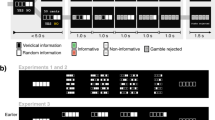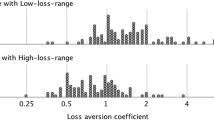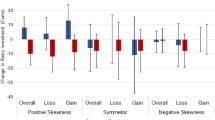Abstract
Previous research suggests that human reaction to risky opportunities reflects two contradicting biases: “loss aversion”, and “limited level of reasoning” that leads to overconfidence. Rejection of attractive gambles is explained by loss aversion, while counterproductive risk seeking is attributed to limited level of reasoning. The current research highlights a shortcoming of this popular (but often implicit) “contradicting biases” assertion. Studies of “negative-sum betting games” reveal high rate of counterproductive betting even when limited level of reasoning and loss aversion imply no betting. The results reflect two reasons for the high betting rate: initial tendency to participate and slow learning. Under certain conditions, the observed betting rate was higher than the rate predicted under random choice even after 250 trials with immediate feedback. These results can be captured with a model that assumes a tendency to select strategies that have led to good outcomes in a small set of similar past experiences, and allows for an initial framing effect.




Similar content being viewed by others
Notes
We run more subjects in Game 6 because (under the level-1 assertion) the other games are similar to each other and to the games studied in previous research. Game 6 is different, and provides the clearest discrimination between the current hypotheses.
In addition, the results show higher entry rates in sets that include the letter A. Whereas we have not predicted this pattern in advance, it appears to be consistent with the current overgeneralization story: in many natural settings the signal A implies higher expected outcomes than the signal D.
Under one justification of this assumption, the numerical value of the instructions-based evidence is much larger than the numerical value of the new evidence (between \(-40 \mathrm{and} +40\)). For example, if the value is \(+\)1,000 or \(-\)1,000 the existence of single instructions-based evidence in the sample masks the effect of at least 25 new experiences. The probability of the event “at least one instructions-based evidence in the sample after \(\hbox {t}_{\mathrm{set}}\) experiences with a particular information set” is \(1-(\hbox {t}_{\mathrm{set}} /[\hbox {s} + \hbox {t}_{\mathrm{set}}])^{k}\).
References
Ball SB, Bazerman MH, Carroll JS (1991) An evaluation of learning in the bilateral winner’s curse. Organ Behav Hum Decis Process 48:1–22
Benartzi S, Thaler RH (1995) Myopic loss aversion and the equity premium puzzle. Quart J Econ 110:73–92
Bereby-Meyer Y, Grosskopf B (2008) Overcoming the winner’s curse: an adaptive learning perspective. J Behav Decis Mak 21:15–27
Camerer CF, Ho TH, Chong JK (2004) A cognitive hierarchy model of games. Q J Econ 119:861–898
Carroll JS, Bazerman MH, Maury R (1988) Negotiation cognition: a descriptive approach to negotiators’ understanding of their opponents. Organ Behav Hum Decis Process 41:352–370
Costa-Gomes M, Crawford VP, Broseta B (2001) Cognition and behavior in normal-form games: an experimental study. Econometrica 69:1193–1235
Erev I, Ert E, Roth AE (2010a) A choice prediction competition for market entry games: an introduction. Games 1:117–136
Erev I, Ert E, Roth AE, Haruvy H, Herzog SM, Hau R, Hertwig R, Stewart T, West R, Lebiere C (2010b) A choice prediction competition: choices from experience and from description. J Behav Decis Mak 23:15–47
Erev I, Haruvy H (in press) Learning and the economics of small decisions. In: Kagel JH, Roth AE (Eds) The handbook of experimental economics. Princeton University Press, Princeton
Ert E, Erev I (2008) The rejection of attractive gambles, loss aversion, and the lemon avoidance heuristic. J Econ Psychol 29:715–723
Fischbacher U (2007) z-Tree: Zurich toolbox for ready-made economic experiments. Exp Econ 10:171–178
Fox CR, Tversky A (1998) A belief-based account of decision under uncertainty. Manag Sci 44:879–895
Gilboa I, Schmeidler D (1995) Case-based decision theory. Q J Econ 110:605–639
Grosskopf B, Bereby-Meyer Y, Bazerman MH (2007) On the robustness of the winner’s curse phenomenon. Theory Decis 63:389–418
Johnson EJ, Goldstein D (2003) Do defaults save lives? Science 302:1338–1339
Kahneman D, Tversky A (1979) Prospect theory: an analysis of decision under risk. Econometrica 47:263–291
Knetsch JL, Sinden JA (1984) Willingness to pay and compensation demanded: experimental evidence of an unexpected disparity in measures of value. Q J Econ 99:507–521
Milgrom P, Stokey N (1982) Information, trade and common knowledge. J Econ Theory 26:17–27
Nagel R (1995) Unraveling in guessing games: an experimental study. Am Econ Rev 85:1313–1326
Odean T (1999) Do investors trade too much? Am Econ Rev 89:1279–1298
Osborne MJ, Rubinstein A (1998) Games with procedurally rational players. Am Econ Rev 88:834–847
Perets H, Sonsino D (1999) On preplay negotiations and zero-sum betting. Int Game Theor Rev 1:192–196
Redelmeier DA, Tversky A (1992) On the framing of multiple prospects. Psychol Sci 3:191–193
Rogers BW, Palfrey TR, Camerer CF (2009) Heterogeneous quantal response equilibrium and cognitive hierarchies. J Econ Theory 144:1440–1467
Roth AE, Erev I (1995) Learning in extensive form games: experimental data and simple dynamic models in the intermediate term. Games Econ Behav 8:164–212
Samuelson PA (1963) Risk and uncertainty: a fallacy of large numbers. Scientia 98:108–113
Samuelson W, Bazerman MH (1985) Negotiation under the winner’s curse. In: Smith VL (ed) Research in experimental economics. Jai Press, Greenwich, pp 105–137
Samuelson W, Zeckhauser R (1988) Status quo bias in decision making. J Risk Uncertain 1:7–59
Sebenius JK, Geanakoplos J (1983) Don’t bet on it: contingent agreements with asymmetric information. J Am Stat Assoc 78:424–426
Selten R, Chmura T (2008) Stationary concepts for experimental \(2 \times 2\) games. Am Econ Rev 98:938–966
Shefrin H, Statman M (1985) The disposition to sell winners too early and ride losers too long: theory and evidence. J Finance 40:777–790
Sonsino D, Erev I, Gilat S (2001) On rationality, learning and zero-sum betting: an experimental study of the no-betting conjecture. Working Paper, http://ie.technion.ac.il/Home/Users/erev/Sonsino_Erev_Gilat_2001.pdf. Accessed 30 March 2014
Sonsino D (1995) “Impossibility of speculation” theorems with noisy information. Games Econ Behav 8:406–423
Sonsino D (1998) Sebenius and geanakoplos model with noise. Int J Game Theory 27:111–130
Søvik Y (2009) Strength of dominance and depths of reasoning: an experimental study. J Econ Behav Organ 70:196–205
Stahl DO (1996) Boundedly rational rule learning in a guessing game. Games Econ Behav 16:303–330
Stahl DO, Wilson PW (1995) On players’ models of other players: theory and experimental evidence. Games Econ Behav 10:218–254
Thaler RH, Tversky A, Kahneman D, Schwartz A (1997) The effect of myopia and loss aversion on risk taking: an experimental test. Q J Econ 112:647–661
Tom SM, Fox CR, Trepel C, Poldrack RA (2007) The neural basis of loss aversion in decision making under risk. Science 315:515–518
Tor A, Bazerman MH (2003) Focusing failures in competitive environments: explaining decision errors in the monty hall game, the acquiring a company problem, and multiparty ultimatums. J Behav Decis Mak 16:353–374
Wedell DH, Böckenholt U (1994) Contemplating single versus multiple encounters of a risky prospect. Am J Psychol 107:499–518
Acknowledgments
This paper was supported by a grant from the Israel Science Foundation. The paper benefitted for constructive comments from the participants of the “Theory, Decision, and Applications” meeting held in Paris in June 2011. All authors contributed equally.
Author information
Authors and Affiliations
Corresponding author
Appendices
Appendix 1: instructions of “Game Betting 6”
You are given the possibility to participate in a betting-game as follows:
-
The game has two players: One and Two
-
The bet has four possible outcomes represented by letters: A, B, C, and D
-
The probability of each outcome is 1/4
The payoff to both players will be determined by the following rule:
-
If the realized state is A, Player 2 will pay Player 1 40 points
-
If the realized state is B, Player 1 will pay Player 2 30 points
-
If the realized state is C, Player 2 will pay Player 1 20 points
-
If the realized state is D, Player 1 will pay Player 2 10 points
You have to decide whether you would want to participate in the bet without knowing the actual realized state. Yet, the bet’s organizers will give you some partial information (signal) concerning the realized state before your decision.
-
Player 1 will receive the signal “A or B” when the realized state is A or B. He will get the signal “C or D” when the realized state is C or D.
-
Player 2 will receive the signal A when the realized state is A, the signal “B or C” when the realized state is B or C, and the signal D when the realized state is D.
The structure of the bet is summarized in the next figure:

The bets’ payoffs will be actually played only if both players (1 and 2) will decide to accept the bet. If one of the players will decide to reject, the bet will not take place and each player will get a payoff of +6 points.
The experiment includes 250 rounds. In each round of the experiment, you have to decide whether you would like to take the bet. If you decided to accept the bet, you should press Enter. Otherwise, you should press Stay Out.
After each round of the experiment, you will observe a feedback window disclosing the following information:
Your response
The other player’s response
The realized state
Your payoff for that round
Your foregone payoff for that round
Your total accumulated score
To exit the feedback window and move to the next trial, you should press Continue.
You start the experiment with 3,000 points.
Your payoff will be determined by your final cumulative score at the end of the experiment. The value of each point is 1 agora (0.01 Shekels).
Appendix 2: instructions of Experiment 2
1.1 Condition Enter
The current experiment includes 250 rounds. In each round, you are given the possibility to participate in a game that has four possible states represented by letters: A, B, C, and D. The probability of each state is 1/4.
You have to decide whether you want to participate in the game without knowing the actual realized state. Yet, the bet’s organizers will give you some partial information (signal) concerning the realized state before your decision. The potential gain or loss from participating in the bet is predetermined by a payoff rule for each realized state.
At each trial you have to decide between “Enter” and “Stay out.” If you decide to stay out you will get a fixed payoff of 6 points. If you decide to enter, your payoff can differ from 6 points.
After each round of the experiment, you will observe a feedback window disclosing the following information:
Your response
Your payoff for that round
Your foregone payoff for that round
Your total accumulated score
You start the experiment with 3,000 points.
Your payoff will be determined by your final cumulative score at the end of the experiment. The value of each point is 1 agora (0.01 Shekels).
1.2 Condition risk
The instructions in condition risk were identical to the instructions in Condition Enter with the exception that third paragraph (in italic) read as follows:
At each trial you have to decide between “safe participation and data collection” and “risky participation and data collection.” If you decide to participate and collect data safely, you will get a fixed payoff of 6 points. If you decide to participate riskily, your payoff can differ from 6 points.
Rights and permissions
About this article
Cite this article
Erev, I., Gilat-Yihyie, S., Marchiori, D. et al. On loss aversion, level-1 reasoning, and betting. Int J Game Theory 44, 113–133 (2015). https://doi.org/10.1007/s00182-014-0421-2
Accepted:
Published:
Issue Date:
DOI: https://doi.org/10.1007/s00182-014-0421-2




